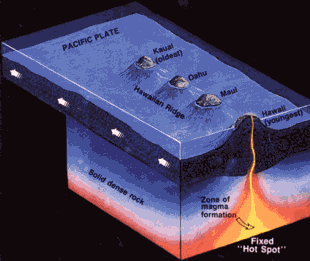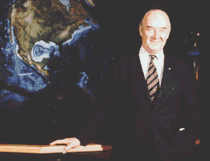John Tuzo Wilson
Beneath all the wealth of detail in a geological map lies an elegant, orderly simplicity. -John Tuzo Wilson
Thursday, 16 March 2017
Historical Information and Background
John Tuzo Wilson was born in Ottawa, Ontario
on October 24, 1908. He was the son of well-known mountain climber Henrietta Wilson and Scottish engineer John Armistead. John Tuzo Wilson was the oldest of three children. He loved being outdoors, and spent much of his childhood canoeing, skiing and swimming with his siblings. He also loved climbing mountains, just like his mother, and the Wilson mountain range in Antarctica was named in his honour.
John Tuzo Wilson was first introduced to the field of geology at the age of seventeen, when he became an assistant for an English geologist named Noel Odell. He continued to study geology at the University of Toronto, and in 1930 he received his Bachelor of Arts degree in geology and physics. He was the first person to receive a degree in geophysical studies in Canada. Shortly after, he earned his second bachelor degree from Cambridge University. In 1936, he received his Ph.D in geology from Princeton University.
After he completed school, he did field work for the Geological Survey of Canada, then served during World War II in the Canadian Army. In 1946, he returned to the University of Toronto as a geophysics professor, and in 1967 he became the first principal of the Erindale College at University of Toronto. John Tuzo Wilson was named the Director General of the Ontario Science Centre in 1974 and he was the chancellor of York University from 1983 to 1986. He died at the age of 84 in Toronto, Ontario on April 15, 1993.
John Tuzo Wilson was first introduced to the field of geology at the age of seventeen, when he became an assistant for an English geologist named Noel Odell. He continued to study geology at the University of Toronto, and in 1930 he received his Bachelor of Arts degree in geology and physics. He was the first person to receive a degree in geophysical studies in Canada. Shortly after, he earned his second bachelor degree from Cambridge University. In 1936, he received his Ph.D in geology from Princeton University.
After he completed school, he did field work for the Geological Survey of Canada, then served during World War II in the Canadian Army. In 1946, he returned to the University of Toronto as a geophysics professor, and in 1967 he became the first principal of the Erindale College at University of Toronto. John Tuzo Wilson was named the Director General of the Ontario Science Centre in 1974 and he was the chancellor of York University from 1983 to 1986. He died at the age of 84 in Toronto, Ontario on April 15, 1993.
Wednesday, 15 March 2017
Contributions to the Field of Study
John
Tuzo Wilson was a geophysicist who spent the majority of his career making
advancements in Earth sciences and geophysics. He was critical in providing solid
evidence to support the plate tectonics theory.
Contributions to the Theory of Plate Tectonics
John Tuzo Wilson's contributions to geophysics and other
science-related fields have helped transform our understanding of how the Earth
works and have also led to many scientific advances. John Tuzo Wilson is respected
for his major contributions to the theory of plate tectonics which includes the
establishment of hotspots and the identification of transform boundaries.
Some
scientists denied the plate tectonic theory because areas containing active volcanoes were located in the middle of plates instead of near a subduction zone. In
1963, John Tuzo Wilson introduced the concept of hotspots to explain why areas containing active volcanoes were located in the middle of plates. He used the
Hawaiian Island chain as an example to support his new theory. He suggested
that the Hawaiian Island chains were formed as a result of a plate moving over
a fixed 'hotspot' in the mantle while the islands containing active volcanoes remained
stationary over the 'hotspot'.
John Tuzo Wilson's other notable contribution to the plate tectonic theory was the identification of a third kind of plate boundary known as transform faults. Convergent and diverge
Other scientific contributions
John
Tuzo Wilson revolutionized the field of geophysics in numerous ways with his
many significant contributions.
-John Tuzo Wilson organized the world's oceans according to the stages of development in a cycle that is referred to as the Wilson Cycle.
-John Tuzo Wilson organized the world's oceans according to the stages of development in a cycle that is referred to as the Wilson Cycle.
-In
order to explain the seafloor spreading, he suggested that sea
floors open, spread, and then close in recurrent cycles. He suggested that this was the case for the Atlantic Ocean. He proposed that the Atlantic Ocean floor had opened, closed, and reopened
again, which caused the Appalachian Mountains to form.
-John
Tuzo Wilson helped establish the use of air photos for geological mapping,
which helped him create the first glacial map of Canada.
Tuesday, 14 March 2017
Seismologist Job Description
Seismologists are Earth
scientists who specialize in geophysics. They study seismic waves, which are
waves of energy that can either be caused by rock suddenly breaking apart
within the earth's crust or by tectonic plates sliding. These events are
commonly known as earthquakes. Some seismologists work in laboratories
and on research sites, while others work in offices to interpret
data.
Seismologists also monitor active volcanoes to look for signs that could indicate an upcoming eruption. They use seismographs, computer equipment and other tools to help them analyze data about shifts that occur within the earth's crust. Seismologists study the geological makeup and structure of the earth and their research has played a vital role in the development of tsunami warning systems and many other major developments.
It is common for seismologists to work in the petroleum industry, where they monitor seismic waves from controlled sources such as vibrations from trucks and explosions. The information that they collect helps them search for sources of natural gas and petroleum that may be found underground.
Seismologists may also observe earthquakes and volcanoes to study naturally occurring seismic waves. They investigate the results of earthquakes such as tsunamis and landslides. They help warn and protect the public and reduce future risk by predicting any future harmful geological events. They do this by interpreting the data they collect and by conducting hypothetical research based on the structures of the Earth.
Seismologists also carry out field studies, where they gather samples of rock, then analyze the samples in a lab. They also examine air photos, rock samples, and other information to help them evaluate the vibrations of the Earth.
Seismologists also monitor active volcanoes to look for signs that could indicate an upcoming eruption. They use seismographs, computer equipment and other tools to help them analyze data about shifts that occur within the earth's crust. Seismologists study the geological makeup and structure of the earth and their research has played a vital role in the development of tsunami warning systems and many other major developments.
It is common for seismologists to work in the petroleum industry, where they monitor seismic waves from controlled sources such as vibrations from trucks and explosions. The information that they collect helps them search for sources of natural gas and petroleum that may be found underground.
Seismologists may also observe earthquakes and volcanoes to study naturally occurring seismic waves. They investigate the results of earthquakes such as tsunamis and landslides. They help warn and protect the public and reduce future risk by predicting any future harmful geological events. They do this by interpreting the data they collect and by conducting hypothetical research based on the structures of the Earth.
Seismologists also carry out field studies, where they gather samples of rock, then analyze the samples in a lab. They also examine air photos, rock samples, and other information to help them evaluate the vibrations of the Earth.
Saturday, 11 March 2017
Education Requirements
A career in seismology is an excellent option for someone with an education background similar to John Tuzo Wilson. In university, aspiring seismologists should take courses in geology, physics and mathematics. A bachelor's degree in geophysics or a similar area is required to become a seismologist. Aspiring seismologists can pursue many different undergraduate degrees, however, an undergraduate degree in geophysics is the best option because it is directly related to seismology. Most careers in observational seismology, specifically in the petroleum industry, usually only require a bachelor's degree.
Careers in research
seismology require a Ph.D. degree. A Master of Science degree in an area
such as geophysics is also extremely beneficial as it will offer specialized knowledge. A master's degree also allows seismologists
to work as consultants for environmental and engineering firms.
Internships are not mandatory, but can be an asset for future job applications
as it will provide extra training and experience.
Computer skills are a vital asset and can even be crucial in seismology related careers as seismologists depend on computers to analyse and interpret data to perform their work. Seismologists must be comfortable working alone and also closely with others to collaborate and solve problems. They should also have good communication skills in order to explain their findings to their team. Most seismologists in Canada work at universities, with engineering firms or with the Geological Survey of Canada.
Some excellent schools to study seismology include:
-University of Toronto
- University of British Columbia
- University of Calgary.
Friday, 10 March 2017
References
https://www.e-education.psu.edu/earth520/content/l2_p7.html
http://www.encyclopedia.com/people/science-and-technology/geology-and-oceanography-biographies/john-tuzo-wilson
https://www.britannica.com/biography/J-Tuzo-Wilson
http://www.thecanadianencyclopedia.ca/en/article/john-tuzo-wilson/
https://www.e-education.psu.edu/earth520/node/1809
http://www.encyclopedia.com/people/science-and-technology/geology-and-oceanography-biographies/john-tuzo-wilson
https://www.britannica.com/biography/J-Tuzo-Wilson
http://www.thecanadianencyclopedia.ca/en/article/john-tuzo-wilson/
https://www.e-education.psu.edu/earth520/node/1809
Subscribe to:
Comments (Atom)



